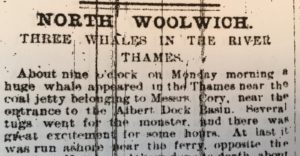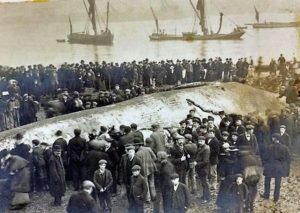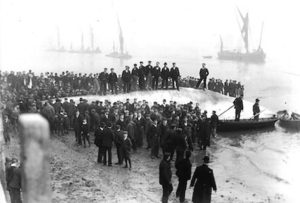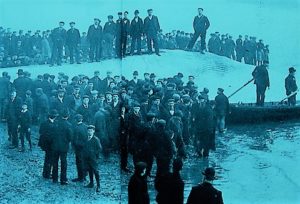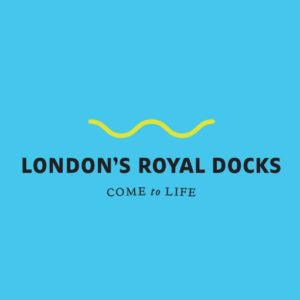Day a giant whale lost her way in Thames at North Woolwich
There’s a long tradition in East London both for children and adults of putting your own lyrics to popular songs…many of us still do it frequently today.
And in the age of phone apps, YouTube and social media, an industry now seems to have grown out of that tradition. Comics use it in their stand-up routines as well.
When we first decided on the topic for the latest in the Forgotten Stories series I was of the alternative verse we used to sing as children and teenagers and still do as adults to the wartime classic We’ll Meet Again from East Ham’s very own Dame Vera Lynn.
The ironic “Whale Meat Again” used to echo round the dinner hall at Silvertown’s Drew School!
We go back 118 years ago to the day when a giant whale lost her way in the River Thames at North Woolwich, was sadly rammed by tugs and subjected to what today would be regarded as animal cruelty.
She was attacked with hatchets and crowbars until she was killed.
Current North Woolwich resident Joan Plant, who will soon be 91, said her mother and father passed down the story to her from the previous generation.
“It created a bit of local history and apparently many locals went down to see the beached whale and some took souvenirs and posed for pictures on top of the animal,” she said.
Former Silvertown resident Lottie Lowry, who passed away in 2012, often told her family stories of the event, passed down to her by her father.
“I can remember being told stories of the whale being washed up on Bargehouse shore (near Bargehouse Road), North Woolwich, and people went down there to cut pieces off meat our for souvenirs and also to eat,” she said back in 2003.
Her nephew, current Silvertown resident Brian Cook, agreed it was a story passed down over the years.
“It seems shocking now, but it was the reaction of people at the time. I think the last time it happened in the Thames was about ten years ago, and off course, people are much more animal welfare conscious now.”
Historian Howard Bloch, writing in the Archive Photographs Series Newham Dockland over 22 years ago observed: “The carcass, which measured about 66ft in length and 33 feet in girth was towed back to the North Woolwich shore near the Royal Victoria Gardens where hundreds came to see her and hack off souvenir pieces.”
During the research for this Forgotten Stories piece, it emerged that three whales had been caught, as the main whale, the mother, was pregnant with two babies.
The Stratford Express carried no mention of the incident in its first edition two days after the event. But in their secondly weekly paper on December 2, they reported, under the headline North Woolwich: Three Whales in the River Thames, how, at around nine o’clock on the Monday morning, the whale appeared “near the coal jetty belonging to Mssrs Cory, near the entrance to Albert Dock Basin.”
The paper said: “Several tugs went for the monster, and there was great excitement for some hours. At last it was run ashore near the Woolwich Ferry, and there done to death, at about one o’clock, but not without a tremendous struggle.
It measured 66ft 7ins long and weighed about 30 tons.
“On Wednesday afternoon, the mammal, which had been rapidly decomposing, burst and disclosed two calves.
“Three men, named Frederick Martin, John Burton and Alfred Joy, opened and delivered the young ones, the first one at 3.15pm and the other one at 3.45pm.
“The first lived about 20 minutes and the second about four minutes.
“During Wednesday night, one was stolen. The young whale remaining, like the older one, has been on exhibition. It measures 17ft 4 ins with a girth of 4ft.
Mr W Harris of Woolwich Local Board (the council which then covered Woolwich and North Woolwich), Mr Arthur Camp and the proprietor of the Pavilion Hotel (North Woolwich( Mr White, collected £23 8s and 6d from sightseers which has been sent to The Mansion House Fund. ( A relief fund set up in the 19th century for various charitable relief projects and collected by the Lord Mayor of London through public appeals.)
“Visitors are still going to see the creature, though it is now in a very offensive condition and any further donations will go to the same fund.”
Rather grimly the report concluded: “Curiosity mongers have cut away lumps of flesh.”
The story of the whale has been passed down.
Bill Stevens, formerly from Canning Town, who now lives in Chelmsford, remembers his father telling him the tale, as told to him by his father.
“The crowds turned up to see the event and even children were there. Some actually stood on top of the whale and others, as was reported at the time, carved pieces off it for souvenirs. People were charged to some and see it and it raised money for charity. It was animal cruelty for sure but not looked upon as such back in those days.”
Other reports at the time varied in their accuracy…
The London Post reported:
“A bottle-nosed whale, forty feet long, weighing eight tons, and valued at £100, was stranded at 12:20 o’clock yesterday afternoon. It came up the river with the tide, and when it found itself stranded on the reed bed “blew” furiously. In struggling to escape the whale Injured itself on the stones, colouring the river with its blood. About two o’clock the crew of the steam tug Empress fastened a rope to it, dragged it off the beach, and took it in tow, with the intention of consulting with the Thames Conservancy as to what was to be done with the monster.”
A second report from the same paper said:
“A whale in the Thames! He measures 66 ft. long and is of the bottle-nosed variety. After an exciting chase extending over four hours, the monster was hemmed in by two tugs, and driven on to a bank. Here he spouted in great style, to the instruction and entertainment of the crowd, and after his death the fishermen set to work on him with knives and cut off steaks for home consumption. There is still plenty of him left for the excursionists who go down to gaze on his magnificent proportions.”
The Essex Field Club used to carrying reports on plants and animals, brought a different perspective.
STRANDING OF A COMMON RORQUAL WHALE IN THE THAMES AT NORTH WOOLWICH, ESSEX.
“About nine o’clock on the morning of Monday, the 27th November last, a great Whale appeared in the Thames in the stretch of the river called Galleons (now Gallions) Reach, which runs from the Albert Docks to Barking Creek. Several tugs went out to capture the animal. It is stated by reporters that for four hours the tugs chased the visitor from Trip Cock Point to Silvertown Petroleum Works, and “the whale responded by whisking her tail vigorously and drenching the hunters with dirty Thames water.” At last it was run ashore near the ferry at the Pavilion Hotel, North Woolwich, and there done to death, but not without a tremendous struggle.
One report stated that the whale “gave a magnificent spouting exhibition just before the end. Onlookers estimated the spout of water at 40 or 50 feet high” The whale was a female, measuring 66 feet 7 inches long, with a girth of 33 feet, and was estimated to weigh about 30 tons. On the Wednesday, the mammal, which had been rapidly decomposing, burst, and disclosed two calves. Some men slit the body open and delivered the young ones, one living about 20 minutes and the other only a very short time. During the night one was stolen, but one remained on exhibition with its mother. It measured 17ft with a girth of 7 feet.
The animal was announced in the papers as a “Bottle-nosed Whale” but this was clearly an error, and in a letter Mr. R. Lydekker, F.R.S., has kindly given us the correct name of the species. Mr. Lydekker writes, “I myself went down to look at the whale, As most of our readers know, this spout of “water” is in reality a column of air from the lungs highly charged with vapour and possibly carrying up with it some of the water surrounding the “blow-hole” of the whale should it spout from below the surface.”
Stan Dyson , who lives in North Woolwich for many years, said the story has been passed down throughout the years but the accuracy of how much “was carved off the animal” at the time will probably never truly be known.
Valerie Gutteridge, who still lives in the area, said: “It is a story we hear mentioned over the years and is shocking when you think of how we would view it today but it certainly created a lot of interest at the time by all accounts.”
One former local resident, who now llives in Essex, , spent much of his life in North Woolwich and Silvertown and who worked in the Thames on Sun Tugs, agreed the whale story had been told by his elders.
“It was something not many of us believed until someone showed us a picture, but then you understand how it could have happened,” he said.
Surprisingly more than than 40 whales, almost 2,000 seals and 450 porpoises and dolphins have been sighted in the River Thames in the past 12 years, but none in our neck of the water.
Canary Wharf is the most likely location to spot large marine life, probably because of its high vantage points, the Zoological Society of London said. Seals have been seen as far upstream as Hampton Court, with dolphins and porpoises sighted at Teddington Lock.
The spokeswoman said: “People are often surprised to hear that marine mammals are regularly spotted in central London. As top predators, their presence is a good sign that the Thames is getting cleaner and supporting many fish species.”
The sightings, often by members of the public, were recorded between 2004 and 2014 as part of the ZSL Thames Marine Mammal Sightings Survey
An amusing footnote to our whale story from 118 years ago, comes from Alfred Wright, from North Woolwich, told the tale of another whale….this time more than 40 years later after the one found in 1899.
He was six at the time and said: “In the second World War a lorry came around the streets selling the whale meat so that people could eat it.”
He said the taste of it was like eating leather soles and it really smelt!
Pictures: Newham Archives and Local Studies Library and Colin Grainger
This article is part of the #Forgotten Stories series
To see all the stories and videos in the Forgotten Stories series go to:
http://www.londonsroyaldocks.com/forgotten-stories/


